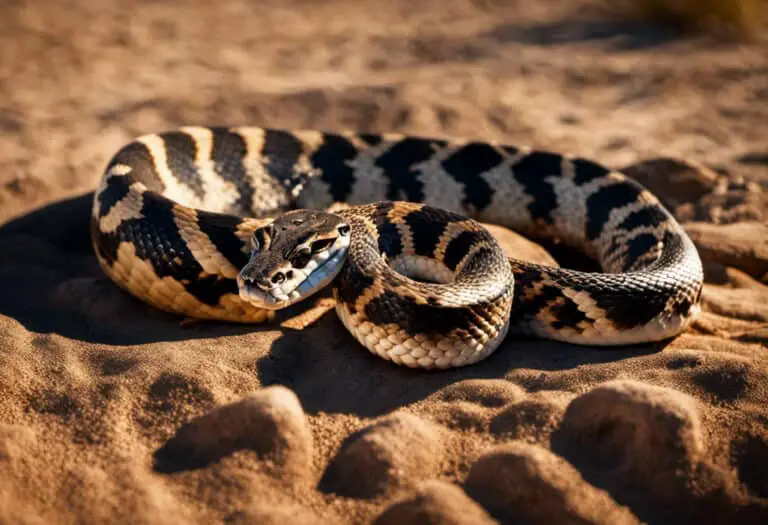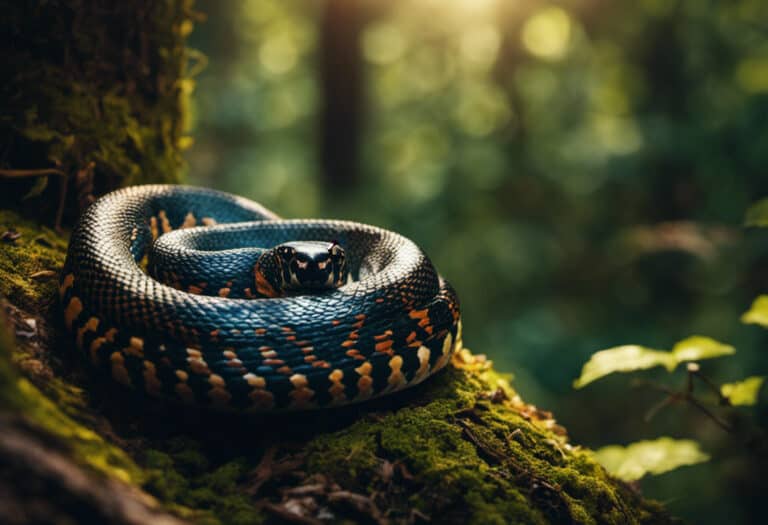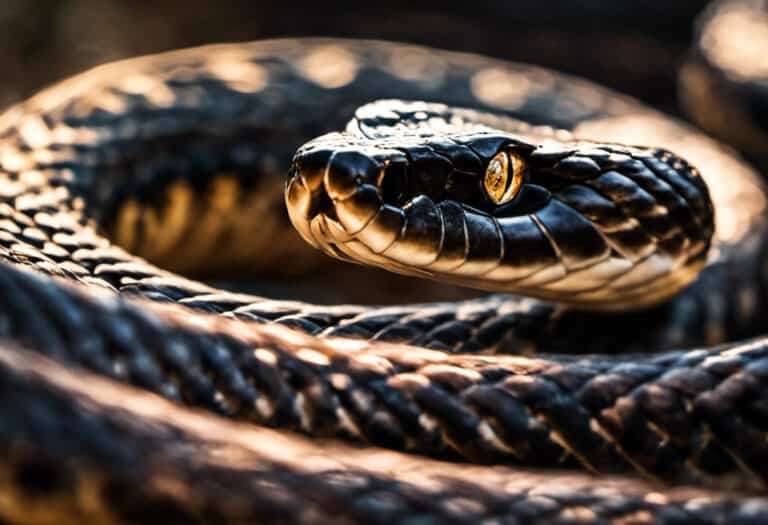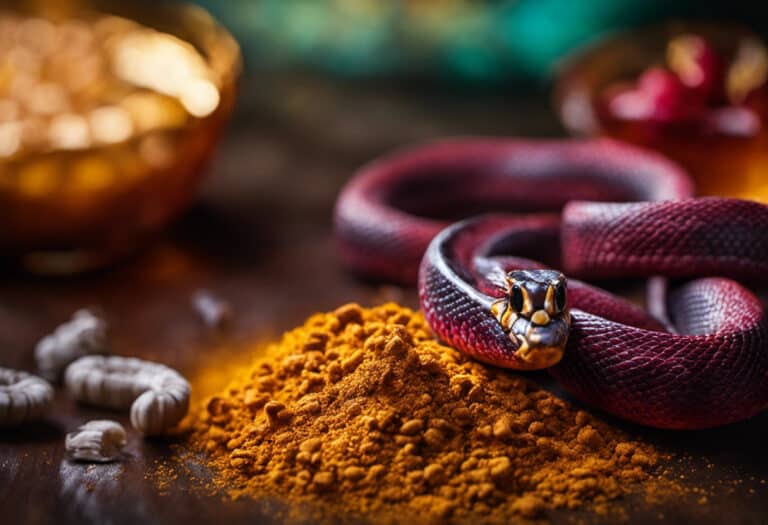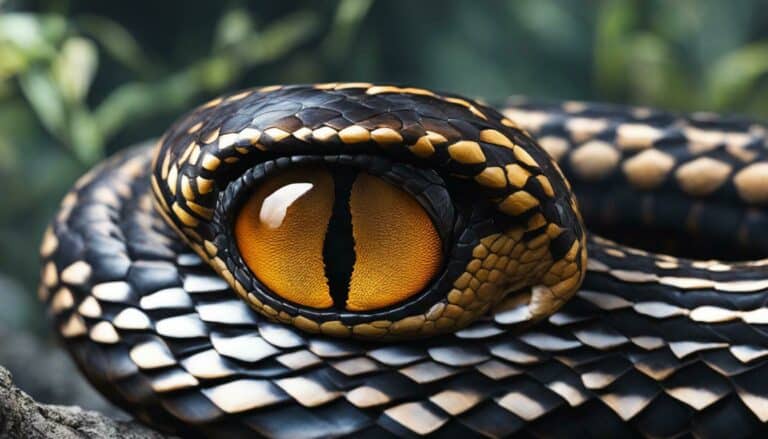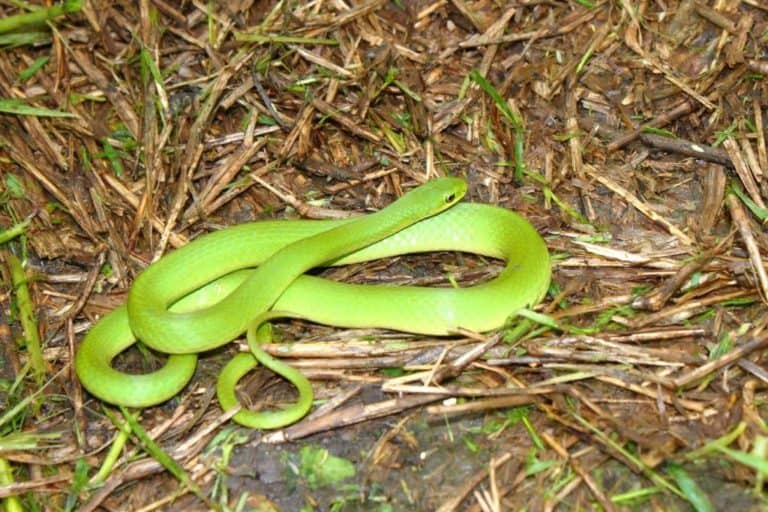Do Snakes Chew Their Food?
Do you ever dare to delve into the depths of how snakes devour their dinner without the dainty act of chewing?
Delight in the knowledge that snakes possess a jaw structure so distinct and a swallowing process so mesmerizing, allowing them to gulp down prey much larger than their own head.
Dismiss the myth of dislocated jaws; instead, witness the wondrous flexibility of their lower jaw, the mighty muscles that expand their mouths wide.
Prepare to be captivated by the captivating journey of digestion as we unravel the secrets of these serpentine creatures.
Key Takeaways
- Snakes do not have chewing teeth and do not chew their food. They rely on their specialized jaws and teeth for gripping and holding prey.
- Snakes have a unique jaw structure with flexible skulls and many joints. Their lower jaw can move independently, allowing them to stretch their mouths wide to accommodate large prey.
- Snakes use a process called peristalsis to move prey down their bodies. This involves the contraction of muscles to push the prey further into the snake’s throat and down its digestive system.
- Digestion in snakes is aided by a highly acidic stomach and digestive enzymes that break down prey. The stomach lining secretes hydrochloric acid, breaking down the prey into a liquid-like substance that can be absorbed through the snake’s stomach lining.
Snake Jaw Structure and Adaptations
Contrary to popular myth, you may be surprised to learn that snakes don’t actually dislocate their jaws. Snakes have a unique adaptation that allows them to increase their jaw width, known as gape.
Their lower jaw, called mandibles, isn’t connected like in mammals, but can spread apart laterally, increasing the width of the mouth. The mandibles are loosely connected at the back to the skull, allowing for greater rotation.
This flexibility in the snake’s jaw structure enables them to swallow prey larger than their own head. As the snake’s head moves forward in a side-to-side motion over the prey’s body, the mandibles move independently, slowly inching the prey into the throat.
Backward-pointing teeth help prevent the prey from escaping during the swallowing process.
The Swallowing Process in Snakes
When swallowing prey, you can observe the snake’s head moving forward in a side-to-side motion over the prey’s body. This is one of the snake’s swallowing techniques.
The snake’s mandibles move independently, slowly inching the prey into its throat. The backward-pointing teeth help prevent the prey from escaping.
Once the prey is in the snake’s throat, peristalsis comes into play. Peristalsis is a muscle contraction that moves the prey down the snake’s body. The snake’s powerful muscles contract and relax in a wave-like motion, pushing the prey towards the stomach.
This process allows the snake to swallow prey larger than its own head. Peristalsis is an essential part of snake digestion, aiding in the breakdown and movement of food through the digestive system.
Chemical Digestion in Snakes
As you may know, snakes chemically digest their food using digestive enzymes and highly acidic stomachs.
The snake digestion process begins when the snake swallows its prey, which is then pushed back into its throat through the use of powerful muscles and a process called peristalsis.
Once in the stomach, the prey is broken down into a liquid-like substance by the action of digestive enzymes and the secretion of hydrochloric acid. The snake’s stomach lining absorbs the nutrients from the broken down prey.
The digestion time varies depending on the snake species, prey size, and temperature. After a large meal, snakes can go weeks or even months without eating.
In some cases, snakes may regurgitate undigested prey as a defense mechanism or if they are stressed or ill. This snake digestion process and feeding behavior allow them to survive and thrive in their natural habitats.
| Snake Digestion Process | Snake Feeding Behavior |
|---|---|
| – Swallowing prey through powerful muscles | – Snakes can swallow prey larger than their own head |
| – Pushing prey back into the throat using peristalsis | – Snakes may regurgitate undigested prey |
| – Digestion with digestive enzymes and hydrochloric acid | – Snakes can go weeks or months without eating after a large meal |
| – Absorption of nutrients through the stomach lining | – Feeding behavior varies among snake species |
Digestion Challenges for Pit Vipers
Digestion challenges for pit vipers arise from their ability to swallow large prey. Due to their large heads and thick bodies, pit vipers can engulf prey that’s larger than themselves. However, this poses a risk as digestion may not outpace putrefaction, potentially causing partially-digested prey to expand inside their bodies.
To overcome this challenge, pit vipers inject venom that turns the prey’s insides into goo, aiding in digestion.
Digestion Risks for Vipers
Pit vipers have an advantage in dealing with slow digestion, as their venom helps prevent partially-digested prey from expanding inside their bodies. This venomous strategy aids in overcoming digestion risks and ensures that the prey doesn’t cause harm to the snake’s internal organs.
The venom injected by pit vipers turns the insides of the prey into goo, aiding in the digestion process. By breaking down the prey’s tissues, the venom allows for easier absorption of nutrients through the snake’s stomach lining.
This adaptation is crucial for pit vipers, as their large heads and thick bodies allow them to swallow large prey, increasing the risk of slow digestion. The venomous properties of pit vipers’ venom serve as a protective mechanism, ensuring efficient digestion and minimizing the potential risks associated with the digestion process.
Venom Aid in Digestion
You might find it fascinating that pit vipers have an advantage in digestion due to the aid of their venom.
Pit vipers, like other snakes, have a unique digestion process. After swallowing their prey whole, snakes rely on their highly acidic stomachs and digestive enzymes to break down the food.
However, pit vipers take it a step further. Their venom, which is injected into their prey during the strike, plays a crucial role in digestion.
The venom contains protein-dissolving enzymes that break down the prey’s insides into a liquid-like substance, making it easier for the snake to absorb nutrients through its stomach lining.
This venomous digestion strategy helps pit vipers overcome the challenges of slow digestion, ensuring efficient nutrient absorption and reducing the risk of partially-digested prey expanding inside their bodies.
Prey Expansion Inside Snakes
If digestion doesn’t outpace putrefaction, partially-digested prey can expand inside your body, posing risks to your health. To prevent this, snakes have evolved unique adaptations in their digestive system.
Here are some key points to understand about prey expansion and digestion risks in snakes:
- Snakes have a highly acidic stomach and digestive enzymes that break down prey into a liquid-like substance.
- The stomach lining secretes hydrochloric acid to aid in the breakdown process.
- Nutrients are absorbed through the snake’s stomach lining.
- Digestion time varies depending on the snake species and factors like prey size and temperature.
- Snakes can regurgitate undigested prey as a defense mechanism or when stressed or ill.
Understanding the intricacies of snake digestion is crucial to ensure their well-being and to appreciate their unique adaptations in the wild.
Venomous Strategies for Digestion
Pit vipers have developed venomous strategies for digestion to overcome the challenges and risks associated with the slow digestion process. Their venom contains enzymes that break down proteins, aiding in the digestion of prey.
This venomous strategy allows pit vipers to efficiently digest their meals and avoid the potential dangers of partially-digested prey expanding inside their bodies.
Pit Viper Venom Digestion
The venom of pit vipers aids in the digestion process by turning the prey’s insides into goo. This venomous strategy helps pit vipers overcome digestion challenges.
Here are some key effects of pit viper venom on digestion:
- Increased stomach acidity: Pit vipers have highly acidic stomachs, and the venom they inject further increases the acidity. This acidic environment helps break down the prey’s tissues and proteins more efficiently.
- Protein digestion: Pit viper venom contains enzymes that break down proteins in the prey’s body. These enzymes help dissolve the prey’s insides into a liquid-like substance, making it easier for the snake to absorb nutrients.
- Facilitates nutrient absorption: The venom also affects the snake’s stomach lining, increasing its ability to absorb nutrients from the prey’s liquefied insides.
- Digestive efficiency: By aiding in the breakdown and digestion of prey, the venom allows pit vipers to extract maximum nutrition from their meals.
- Faster digestion: The venom’s effects on prey’s insides help speed up the digestion process, allowing pit vipers to efficiently process and metabolize their meals.
Overcoming Digestion Challenges
Now, let’s explore how snakes overcome digestion challenges in their unique digestive system. Snakes face the task of digesting venomous prey, which can be a complex process. Their digestive system is designed to handle this challenge effectively.
Firstly, snakes have a highly acidic stomach that secretes hydrochloric acid. This acid, along with digestive enzymes, breaks down the prey into a liquid-like substance. The snake’s stomach lining then absorbs the nutrients from this mixture.
Additionally, some snake species, like pit vipers, have an advantage in dealing with slow digestion. They inject venom into their prey, which aids in digestion by turning the prey’s insides into goo. This venomous strategy helps pit vipers overcome digestion challenges and ensures efficient digestion of their venomous prey.
Digestion Risks and Strategies
You may be surprised to learn that digestion poses risks to snakes, as they’re vulnerable during this process. Snakes have a highly efficient digestion system, but it can still have its challenges. Here are five important points to consider:
- Digestion efficiency: Snakes have a highly acidic stomach, along with digestive enzymes that break down prey. This allows for efficient digestion and absorption of nutrients through the snake’s stomach lining.
- Prey size: The size of the prey can affect digestion time. Larger prey takes longer to digest, as it requires more time for the snake’s digestive system to break it down into a liquid-like substance.
- Digestion time: Digestion time varies depending on the snake species and factors such as prey size and temperature. It can take several days to several weeks for a snake to fully digest a meal.
- Regurgitation: Snakes have the ability to regurgitate undigested prey. This can happen if they feel threatened or stressed, or if they’re ill. Regurgitation allows them to quickly escape from potential danger.
- Strategies: Pit vipers have developed a unique strategy to overcome digestion challenges. They inject venom that turns the prey’s insides into goo, aiding digestion and preventing the expansion of partially-digested prey inside their bodies.
Understanding digestion in snakes is crucial for their overall health and survival. By studying their unique digestive system and the risks they face, we can gain a deeper appreciation for these fascinating creatures.
Factors Affecting Snake Digestion Time
Digestion time in snakes can vary depending on factors such as prey size and temperature.
Larger prey takes longer to digest, while smaller prey can be processed more quickly. Additionally, snakes are ectothermic animals, meaning their body temperature is influenced by their environment.
Lower temperatures can slow down digestion, while warmer temperatures can speed it up. The following table illustrates the impact of prey size and temperature on digestion time in snakes:
| Factors Affecting Digestion Time | Prey Size | Temperature |
|---|---|---|
| Larger Prey | Longer | – |
| Smaller Prey | Shorter | – |
| Low Temperature | – | Slower |
| High Temperature | – | Faster |
Understanding these factors is important for snake owners and researchers to ensure proper care and accurate data collection.
Remember, snakes have their own unique digestive processes that are influenced by various factors, allowing them the freedom to adapt to different prey and environments.
Regurgitation: An Escape Mechanism
If threatened, a snake may quickly regurgitate its prey as a defense mechanism. This fascinating behavior allows snakes to escape from potential danger by expelling the contents of their stomach. Regurgitation is a natural response to stress or illness, and it helps snakes preserve their energy and avoid predation.
However, regurgitated prey is often still intact, providing evidence of the snake’s ability to rapidly reverse the swallowing process.
The factors that affect snake digestion time play a crucial role in determining how quickly a snake can regurgitate its prey. These factors include the size of the prey, as larger meals take longer to digest, and the temperature, as digestion slows down in cooler environments.
Understanding regurgitation as a defense mechanism and the factors affecting snake digestion time can provide valuable insights into the behavior and physiology of these remarkable creatures.
Additional Resources for Snake Digestion Information
If you’re interested in delving deeper into snake digestion, there are a few additional resources available that can provide valuable insights.
JSTOR is a digital library that offers access to a vast collection of research articles. JSTOR Daily, a publication associated with JSTOR, offers free access to original research articles for readers.
One such article titled ‘Kinesis of the Jaw Apparatus during Swallowing in the Cottonmouth Snake, Agkistrodon piscivorus’ by Kenneth V. Kardong provides further understanding of snake swallowing mechanisms.
Another resource to explore is the article ‘Specializations of the Body Form and Food Habits of Snakes’ by F. Harvey Pough and John D. Groves, published in American Zoologist. This article delves into the unique adaptations of snakes’ body structures and their relationship to food habits.
These resources can offer valuable information on snake digestion research, including insights into snake stomach acidity and other aspects of their digestive processes.
Frequently Asked Questions
How Do Snakes Dislocate Their Jaws to Accommodate Large Prey?
Snakes can accommodate large prey by using their unique jaw structure. Their lower jaw can move independently and stretch wide, allowing them to push prey back into their throat. They do not dislocate their jaws.
What Are the Specialized Teeth That Snakes Use for Gripping and Holding Prey?
Snakes have specialized teeth called fangs that they use for gripping and holding prey. These fangs are hollow and connected to venom glands, allowing snakes to inject venom into their prey to immobilize and digest it.
How Long Does It Take for a Snake to Digest Its Prey?
Snakes have a varied digestion timeline, ranging from days to weeks. Factors like prey size and temperature influence digestion. Larger prey takes longer. After a big meal, snakes can go weeks or months without eating.
Why Do Snakes Regurgitate Their Prey?
Snakes regurgitate prey for various reasons, including feeling threatened or stressed. Regurgitation is a defense mechanism that allows them to quickly escape. However, frequent regurgitation can impact a snake’s health, leading to nutrient loss and weakness.
What Are Some Additional Resources for Learning About Snake Digestion?
For additional resources on snake digestion, you can explore books and scientific articles. These sources provide detailed and informative information about the topic. Expand your knowledge and satisfy your curiosity with these valuable resources.
Conclusion
In conclusion, snakes have a fascinating jaw structure and swallowing process that allows them to consume prey without chewing. Contrary to popular belief, their jaws don’t dislocate, but rather their lower jaw can move independently to stretch their mouths wide.
Through peristalsis, snakes are able to move their prey down their bodies for digestion. While digestion time varies, snakes have the ability to regurgitate undigested prey as a defense mechanism.
So, next time you see a snake devour its meal, remember the incredible adaptations that allow them to eat without chewing.
